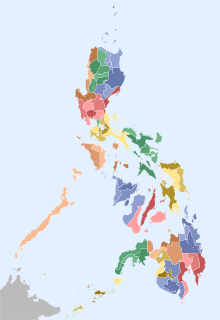
The provinces of the Philippines are the primary political and administrative divisions of the Philippines. There are 81 provinces at present, further subdivided into component cities and municipalities. The local government units in the National Capital Region, as well as independent cities, are independent of any provincial government. Each province is governed by an elected legislature called the Sangguniang Panlalawigan and an elected governor.

Agusan del Norte is a province in the Philippines located in the Caraga region of Mindanao. Its capital is the city of Cabadbaran and it is bordered on the northeast by Surigao del Norte; mid-east by Surigao del Sur; southeast by Agusan del Sur, and southwest by Misamis Oriental. It faces Butuan Bay, part of the Bohol Sea, to the northwest.

Surigao del Norte is a province in the Philippines located in the Caraga region of Mindanao. Its capital is Surigao City. The province comprises two major islands—Siargao and Bucas Grande—in the Philippine Sea, plus a small area at the northeastern tip of mainland Mindanao and other surrounding islands and islets. This mainland portion borders Agusan del Norte, and Surigao del Sur to the south.
The legislative districts of Agusan del Norte are the representations of the province of Agusan del Norte and the highly urbanized city of Butuan in the various national legislatures of the Philippines. The province and the city are currently represented in the lower house of the Congress of the Philippines through their first and second congressional districts.

The legislative district of Mindanao and Sulu was the collective representation of the Department of Mindanao and Sulu and its component provinces of Agusan, Bukidnon, Cotabato, Davao, Lanao, Sulu and Zamboanga as a single at-large district in the lower house of the Philippine Legislature from 1916 until 1935.
The legislative district of Zamboanga was the representation of the historical province of Zamboanga in the various national legislatures of the Philippines until 1953. The undivided province's representation encompassed the present-day provinces of Basilan, Zamboanga del Norte, Zamboanga del Sur and Zamboanga Sibugay, and the highly urbanized city of Zamboanga.
The legislative districts of Agusan del Sur are the representations of the province of Agusan del Sur in the various national legislatures of the Philippines. The province is currently represented in the lower house of the Congress of the Philippines through its first and second congressional districts.
The legislative district of Basilan is the representation of the province of Basilan in the various national legislatures of the Philippines. The province is currently represented in the lower house of the Congress of the Philippines through its lone congressional district.
The legislative districts of Davao City are the representations of the highly urbanized city of Davao in the various national legislatures of the Philippines. The city is currently represented in the lower house of the Congress of the Philippines through its first, second, and third congressional districts.
The legislative districts of Zamboanga del Norte are the representations of the province of Zamboanga del Norte in the various national legislatures of the Philippines. The province is currently represented in the lower house of the Congress of the Philippines through its first, second and third congressional districts.
The legislative districts of Zamboanga del Sur are the representations of the province of Zamboanga del Sur in the various national legislatures of the Philippines. The province is currently represented in the lower house of the Congress of the Philippines through its first and second congressional districts.
The legislative districts of Sulu are the representations of the province of Sulu in the various national legislatures of the Philippines. The province is currently represented in the lower house of the Congress of the Philippines through its first and second congressional districts.
The legislative districts of Davao del Norte are the representation of the province of Davao del Norte in the various national legislatures of the Philippines. The province is currently represented in the lower house of the Congress of the Philippines through its first and second congressional districts.
The legislative district of Davao del Sur is the representation of the province of Davao del Sur in the various national legislatures of the Philippines. The province is currently represented in the lower house of the Congress of the Philippines through its lone congressional district.
The legislative districts of Davao Oriental are the representations of the province of Davao Oriental in the various national legislatures of the Philippines. The province is currently represented in the lower house of the Congress of the Philippines through its first and second congressional districts.
The legislative district of Davao was the representation of the historical province of Davao in the various national legislatures of the Philippines until its dissolution in 1967.
The legislative districts of Cotabato are the representations of the province of Cotabato in the various national legislatures of the Philippines. The province is currently represented in the lower house of the Congress of the Philippines through its first, second, and third congressional districts.
The legislative districts of Lanao del Norte are the representations of the province of Lanao del Norte in the various national legislatures of the Philippines. The province is currently represented in the lower house of the Congress of the Philippines through its first and second congressional districts.
The legislative district of Lanao was the representation of the historical province of Lanao in the various national legislatures of the Philippines until 1969. Marawi and Iligan also remained part of the province's representation even after becoming chartered cities in 1940 and 1950, respectively.
The legislative districts of Lanao del Sur are the representations of the province of Lanao del Sur in the various national legislatures of the Philippines. The province is currently represented in the lower house of the Congress of the Philippines through its first and second congressional districts.




